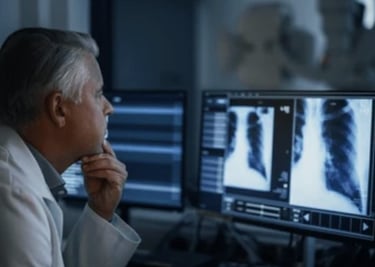Radiology


Diagnostic radiology has always been a high-tech area of medicine and is a natural testing ground for SaMD and AIaMD applications. Indeed, radiology was one of the first medical specialties to accept a properly implemented AI system as a potential ally rather than a threat. Most AI applications are in the area of 'reporting' (image interpretation) but AI is now being applied to each step of the patient's journey through the radiology department. In this broader context, AI is referred to as a workflow augmentation tool and many leading IT suppliers are producing integrated systems to meet this requirement.
Looking back, the introduction of AI systems in radiology got off to a rocky start with Professor Geoffrey Hinton (one of the so-called "Godfathers of AI") stating way back in 2016 that "people should stop training radiologists now, as its just completely obvious that, within 5 years, deep learning is going to do better than radiologists". Well, it didn't happen. Hinton has since admitted his mistake and many hospitals (especially in the U.S.) have recently increased their recruitment of radiologists [ref].
In recent years a number of national radiology professional bodies have issued position papers on the conditions necessary for adoption of AI; a recent report by the UK's Royal College of Radiologists (RCR) being a good example. The RCR has also issued draft guidance on how to conduct post-market surveillance of what it calls "AI tools" (i.e. SaMD) in the light of Great Britain's new legislation on this aspect of medical device regulation. Radiology is also the most popular target area for medical CDS software. More background information on the current and potential use of AI in clinical radiology can be found here.
The latest version of the MHRA's guidance on the qualification and classification of medical device software, including apps (dated July 2023), can be found here. In October 2022 the MHRA also published it's Software and AI as a Medical Device Change Programme Roadmap, which gave an indication of the future direction of UK regulation in this area. All the MHRA's current advice on SaMD and AIaMD is collected here.
